Written By: Ben Cosgrove
On the morning of January 31, 1961, in south Florida, a 5-year-old chimpanzee dubbed “Ham” by his handlers ate a breakfast of baby cereal, condensed milk, vitamins and half an egg. Then the unassuming 37-pound primate went out and made aeronautic history: Aboard a NASA space capsule, traveling thousands of miles an hour almost 160 miles above the Earth, he became the first chimp in space.
The success of Ham’s flight helped ratchet up even further the already frantic contest for scientific and space supremacy between the U.S. and the Soviet Union and briefly made Ham something of a star. Here, LIFE.com commemorates Ham’s 16-minute suborbital mission with photos taken before, during and after his wild ride. The pictures in this gallery capture an era when technology, ideology and propaganda converged in an era-defining struggle known as the Space Race.
Well before the USSR launched the world’s first artificial satellite, in 1957, and obviously long before the U.S. put Neil Armstrong and Buzz Aldrin on the moon, Americans and Soviets used animals to test the rigors and dangers that humans might face in outer space. Mice, rhesus monkeys, dogs—all sorts of creatures blasted off from the surface of the Earth strapped atop rockets and locked in test planes. Many suffered injury; not a few of them died.
Ham and his cohorts were picked for the Mercury program over other hominids (gorillas and orangutans) because they were smaller and could fit in the Mercury capsule and also because “chimpanzees have physical and mental characteristics similar to man,” as LIFE pointed out in its Feb. 10 1961 issue.
The most famous of the Mercury chimps, due to his landmark January 1961 flight, Ham was not publicly called Ham when he went into space. That name—an acronym for Holloman Aerospace Medical Center—was only widely used when he returned safely to earth; NASA reportedly wanted to avoid bad publicity should a named (and thus a known, publicly embraced) animal be killed; all the Mercury chimps were known by numbers.
LIFE’s Ralph Morse—who photographed the Space Race and NASA astronauts for more than a decade—told LIFE.com that even 50 years later, he fondly recalled the astrochimps.
“Ham, especially, was a very friendly fellow,” Morse said. “Those were great assignments, shooting the early years with NASA. You really got the sense that these were incredibly smart people just working their tails off to do something that had never been done before.”
“The training of Ham and other astrochimps,” wrote LIFE, “was a scaled-down version of the human astronauts’. After curing them of jungle diseases and parasites, a special corps of veterinarians … kept track of their skeletal development by periodic X-ray exams, and gave them regular heart, muscle, and ear-nose-and-throat check-ups.”
“All are pre-adolescents,” LIFE wrote of the chimps, “amenable to teaching. All are active, bright, and light in weight — some flunked out of the program by growing to over 50 pounds in weight.” While America relied on chimps and other primates—rhesus monkeys, for example—as suborbital test subjects in the 1950s and early sixties, the Soviets commonly used dogs. (In 1951 and 1952, for example, Soviet rockets carried nine dogs to the edge of space. Three of those dogs died during or immediately following the flights.)
The astrochimps were not trained to “pilot” space capsules, but instead to perform routine tasks during suborbital flights, and to act, in the most elemental way, as test subjects facing little-known physical and psychological perils ahead of their human counterparts in the Mercury program and beyond.
“According to one story, which strict scientists contend is apocryphal,” LIFE wrote, “a veterinarian gave a banana to a chimp before a rocket sled ride. As the animal peeled it, the ride started with a lurch and the monkey got the banana full in the face. The next time the chimp was offered a banana before a sled ride, he took it, peeled it, and smeared it over the veterinarian’s face.”
When Ham finally blasted off from Cape Canaveral, he was well-trained for what lay ahead. “He had a form-fitted couch like the astronauts’. The van which took him to the launching pad was the same van the astronauts will use. The Mercury capsule he rode in was nearly identical to the capsule that will take the astronauts into space, equipped with the same life-support system of oxygen and pressure which will keep the astronauts alive.”
The flight was more demanding than expected.
“Poor Ham,” wrote LIFE, “who was expected to sustain a maximum of 11 Gs, briefly pulled 18” during the flight, “two more than the astronauts have been scheduled for in their training.” Ham, however, seemed to weather it all with aplomb. “[When Ham’s capsule was opened at sea after the flight,” the LIFE report continued, “first a hand was thrust out to shake the anxious vet’s, then Ham stepped out, burping proudly.”
After the flight, Ham lived at the National Zoo in Washington, D.C, and then at the North Carolina Zoo, where he died at age 26 in 1983. His brief pop culture celebrity (he appeared in a film with Evel Knievel, for example) paled beside the significance of his achievement as NASA’s first astrochimp. A short three months after Ham’s 1961 flight, astronaut Alan Shepard piloted the Mercury capsule on his own historic, 15-minute suborbital space flight, and was feted with ticker tape parades in New York and Washington.
“Alan Shepard was a hero, no doubt about that,” Ralph Morse said. “But whenever people call Shepard the first American in space, I like to remind them of a chimpanzee who beat him to it.”

LIFE cover, Feb. 10, 1961. Ham the Chimpanzee in the space capsule after returning from the Mercury Redstone 2 space flight.

Ham the astrochimp after his historic 1961 suborbital flight.
Ralph Morse/Life Pictures/Shutterstock

The rocket sled at Holloman Air Force Base, 1960.
Ralph Morse/Life Pictures/Shutterstock

An astrochimp in training, 1960.
Ralph Morse/Life Pictures/Shutterstock

A hug and a pat were exchanged in a moment of fond reassurance.
Ralph Morse/Life Pictures/Shutterstock

An astrochimp in training.
Ralph Morse/Life Pictures/Shutterstock

A chimp was strapped into a “couch” rigged with all manner of monitoring equipment during a test prior to Ham’s January 1961 flight.
Ralph Morse/Life Pictures/Shutterstock

An astrochimp in training, 1960.
Ralph Morse/Life Pictures/Shutterstock

An astrochimp learned to press buttons in order to reward himself with banana pellets, 1961.
Ralph Morse/Life Pictures/Shutterstock

An astrochimp learned to handle equipment at Holloman Air Force Base, 1960.
Ralph Morse/Life Pictures/Shutterstock

Astrochimps in training, 1960.
Ralph Morse/Life Pictures/Shutterstock

An astrochimp in training at Holloman Air Force Base, 1960.
Ralph Morse/Life Pictures/Shutterstock

Ham, the astrochimp, seemingly mugging for the camera, 1961.
Ralph Morse/Life Pictures/Shutterstock

An astrochimp in training at Holloman Air Force Base, 1960.
Ralph Morse/Life Pictures/Shutterstock

A chimp and a handler looked at X-rays during Mercury training at Holloman Air Force Base, 1960.
Ralph Morse/Life Pictures/Shutterstock

Astrochimps and their handlers, Holloman Air Force Base, 1960.
Ralph Morse/Life Pictures/Shutterstock

An astrochimp at Holloman Air Force Base, 1961.
Ralph Morse/Life Pictures/Shutterstock

An astrochimp at Holloman Air Force Base, 1961.
Ralph Morse/Life Pictures/Shutterstock

Astrochimp, 1960.
Ralph Morse/Life Pictures/Shutterstock

Astrochimps, 1960.
Ralph Morse/Life Pictures/Shutterstock

Ham the astrochimp, 1961.
Ralph Morse/Life Pictures/Shutterstock

Ham the astrochimp and his handler, Cape Canaveral, Florida, 1961.
Ralph Morse/Life Pictures/Shutterstock

Ham the astrochimp, 1961.
Ralph Morse/Life Pictures/Shutterstock

Ham the astrochimp after his 1961 suborbital flight.
Ralph Morse/Life Pictures/Shutterstock

Ham the astrochimp was escorted by a human friend after his suborbital space flight, January 1961.
Ralph Morse/Life Pictures/Shutterstock

A Mercury space capsule carried Ham the astrochimp into space on Jan. 31, 1961. His flight lasted 16 minutes and 39 seconds.
Ralph Morse/Life Pictures/Shutterstock


































